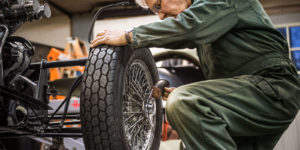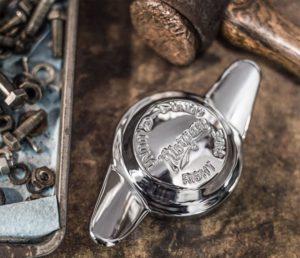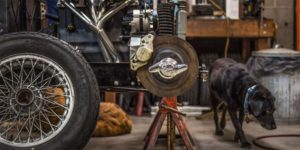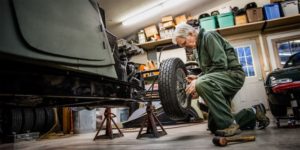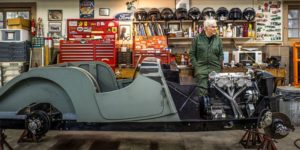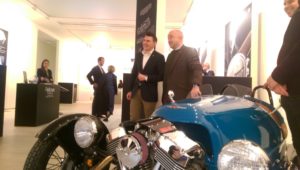Peter Egan gets caught in the great Malvern Morgan trap, and is inexplicably drawn to the 4/4.
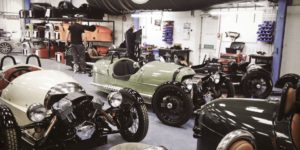
Floating around on a cruise ship, eating and drinking all day in a Hawaiian shirt is all very well, but I’ve always wanted to take a real ocean liner across the North Atlantic specifically to go somewhere. I’d rather face the cruel sea of World War II convoy fame in a sturdy steel ship that cuts through heavy weather unfazed than sit around the pool with a nice umbrella drink in my hand.
And so we did, just a few months ago, in a long-delayed retirement trip. Barb and I flew from Wisconsin to New York, boarded the Queen Mary 2 (a stunningly beautiful ship in all respects—and fast!), sailed past the Statue of Liberty, and arrived seven days later in Southampton, England, in the early morning. Naturally, I had to roll out of bed in the dark at 3:30 a.m. so I could observe our approach. I got a cup of coffee from the cafeteria, walked out onto the chilly promenade deck, and watched the shore lights of the Isle of Wight slide by as we turned up Southampton Water toward our port.
There was only one other person on the deck, a dignified-looking gentleman with white hair and a beard. He, too, was holding a steaming mug of coffee. I recognized him right away as Commodore Ron Warwick, the original captain of the QM2 when it first went to sea in 2004. Now retired, he’d been one of the cruise line’s guest speakers on this 10th-anniversary voyage of the ship, and I’d attended two of his afternoon lectures.
[I had the pleasure of meeting Ron and his lovely wife Kim, at the MOG 15 event in LLangollen Wales. They made a point of ensuring a traveling American had a good bottle of wine at the event! Wonderful folk!! Mark]
I introduced myself and told him how much I’d enjoyed his speeches. He shook my hand and said, “Oh, well, thank you.”
“You’re up early,” I noted.
He chuckled and said, “Old habits. Can’t sleep when we’re coming into Southampton. I did this so many times, I have to watch and see how it goes.” We looked on silently for a while, and then he asked, “Where are you going in England?”
“It’s a little complicated,” I said. “We’re driving a rental car to Dorset to see the homes of Thomas Hardy and T. E. Lawrence, then up to the Cotswolds for a six-day hiking tour. Before we fly home, we’d like to drive over to Malvern to visit Sir Edward Elgar’s home. And the Morgan factory.”
He stared at me intently for a moment, then took a weighty metal pen out of his pocket. “Read the lettering on the side of this pen,” he commanded, with mock imperiousness. I held it to the light and grinned. “Aha! Morgan Owners Club.”
“My wife and I bought a new Morgan when I retired a few years ago,” he explained, “and we take most of our vacations with it. When I get home, we’re going to Scotland.” The word “Morgan” was the secret lodge handshake, and the commodore and I talked sports cars until we docked. It seemed like an excellent and auspicious way to greet England’s shores.
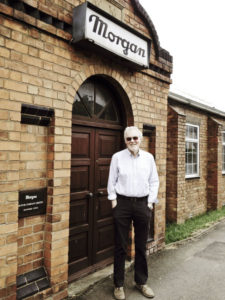
Peter Egan
Barb and I picked up our rental car—a red Vauxhall Corsa—and turned west along the coast to visit our Hardy and Lawrence shrines (Max Gate and Clouds Hill) near Dorchester for a few days, then drove north to the Cotswolds, where we left the car parked in Moreton-in-Marsh during a week of hiking. We covered 50 miles in a great circle of lovely yellow limestone villages, sheep farms, river trails, forests, and the ruins of ancient Cistercian abbeys. Not to mention the pubs. Finally, on a bright Saturday morning, we collected our car and headed west.
As the great green mass of the Malvern Hills loomed ahead, I said to Barb, “Let’s go through the village of Malvern Link on the north edge of town, so we can drive past the Morgan factory. Morgan’s website says it’s closed for tours on Saturday and Sunday, but we can at least find out where it is.”
We soon found ourselves on Pickersleigh Road, pulling up in front of the neat red-brick industrial buildings of the Morgan factory. Holy ground. Surprisingly, the gates were open. A sign said all visitors must report to the visitors’ center, so we asked for directions from a man in overalls.
“Go right down this row of buildings and turn left. You’ll see it at the end of the lane, near the big parking lot.”
We strolled through the grounds, taking pictures of rows of wood-framed bodies and half-completed cars in the many long sheds. A few dozen workers were tidying up for the weekend, putting tools away, or doing last-minute detailing on finished cars. Everyone said good morning with cheerful indifference to our presence. It was like a self-guided tour made in heaven.
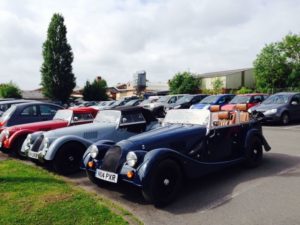
Peter Egan
The visitors’ center was—as advertised—closed for the weekend, so we meandered back to the main gate. As we did, I noticed all the factory doors were now shut, the workers gone. It was suddenly very quiet. When we reached the main gate, it was padlocked. I looked around the grounds and shouted “Hello!” My voice echoed off the brick buildings and died away, unanswered.
“Huh,” I said perceptively. “Looks like everyone’s gone home. Well, the gate was open over at the visitors’ center. Guess we’ll have to go out there.”
But of course, that gate was also now tightly locked. I looked around the silent factory and noted that it was surrounded by a 10-foot fence topped with rows of barbed wire, much like Stalag 17.
Barb and I looked at each other.
“I do believe we’re locked inside the Morgan factory for the weekend,” I said. “This would normally be my fondest boyhood dream come true, but I think we’re going to get mighty hungry and cold if we don’t get out of here.”
Just then, a middle-aged man in a golf shirt came walking past the gate.
“Excuse me,” I said through the wire. “Do you live around here?”
“Just around the corner,” he pointed.
“Well, we seem to have gotten ourselves locked inside the factory. Do you know if there’s any way out of here?”
He looked up and down the fence. “Just the two gates and this fence,” he said. “And I don’t think you’d be able to get over that fence safely, even with a ladder. It goes all the way around the property.”
“I hope we don’t have to call the police . . .” I said.
The man looked at his watch. “I’m sorry to say I have to catch a train and I’m a bit late . . .” He stared at the ground thoughtfully and bit his lower lip. “Say, it looks to me as if a thin person could just wriggle under the gate there, in that low spot where the sewer grate is.”
I looked and saw that he was right, suddenly thankful that Barb and I had been dieting and walking about eight miles a day to train for our trek through the Cotswolds. I got down on my back and slithered under the gate’s iron staves like an infantry trainee in a live-fire exercise. My Army training finally paid off. Barb made it too, even though she had no training at all. But it was a near thing, as Churchill might say. Although Churchill himself would still be trapped.

Peter Egan
I thanked the man for his face-saving advice, and he waved over his shoulder as he sprinted toward the train station. I dusted Barb off, which I thoroughly enjoyed until she made me stop, and then we headed downtown. We found a hotel called the Abbey next to the beautiful Malvern Priory and had a wonderful weekend exploring, paying a visit to the graves of Elgar and his wife Alice in a small churchyard just south of town. Elgar’s Cello Concerto is a favorite of mine, though he’s best known for “Pomp and Circumstance,” which makes me tearfully grateful to be out of high school whenever I hear it.
On Monday morning, Barb and I reappeared at the factory and dutifully paid 15 pounds each to take the official two-hour factory tour. It was much more instructive than our own illicit meanderings, of course, and we got to see the museum and gift shop. We also learned that the new V-twin-powered 3 Wheeler accounts for about half of current Morgan sales. The tour guide told me, “You know, the 2.0-liter V-twin engines are built by a company called S&S in the town of Viola, right in your home state of Wisconsin.”
I told him Viola was about 25 miles from the little town where I grew up. “It’s a beautiful, high-tech factory tucked back in the green hills,” I said. “It could almost be a part of the Malverns.”
He seemed pleased by this vision but perhaps a bit disappointed that I already knew about it. I didn’t tell him we’d already toured the Morgan factory, too.
Before anyone could review the security-camera footage of that little escapade, we sped toward London on the M40, dropped our rental car near Heathrow, and flew home the following morning. I arrived with a suitcase full of loot from the gift shop and perhaps he world’s worst case of Morgan fever.
That night, I called my old Formula Ford racing buddy John Jaeger, who now owns a Mini repair shop in California. I had to tell him about our tour, as he’s owned a series of Morgans and currently has a 1964 4/4 disassembled at home. I told John, “I always thought I’d have a Morgan someday, but I’m afraid the window has closed now that I’m retired. Even old cars that need work seem too expensive, and you never know what you’re getting until you take them apart.”
There was a humming silence for a minute, and then John said, “You know, I don’t think I’m going to find the time to finish my Morgan project. I’d consider selling my 4/4, if you’re interested. Otherwise I’ll probably keep it forever, just to have it.”
This past weekend, I sold a nice older Stratocaster and two classic amps from my small collection of musical instruments. The money is going right into a special savings account. I’m also taking a hard look at the five motorcycles in my garage to see if I really need that many.
The one I won’t sell, however, is the 1974 Norton Commando I finished restoring last spring. I think it might look nice sitting next to a 4/4. I could listen to a little Elgar on the shop stereo while I put it all together next winter.





